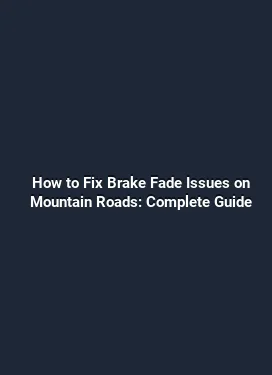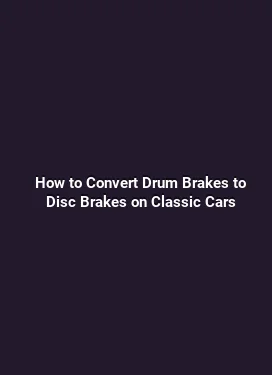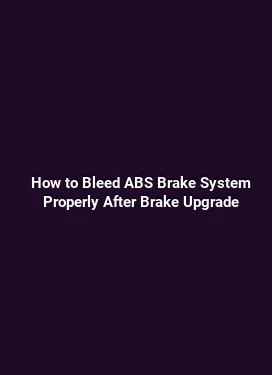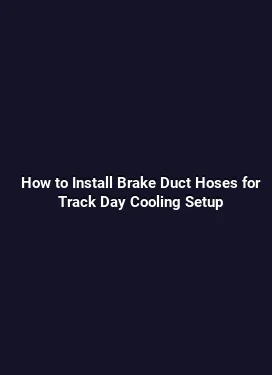Slotted vs Drilled vs Smooth Brake Rotors: A Practical Performance Comparison
Brake rotors form the heart of a vehicle's braking system, translating pedal effort into stopping power. When a driver seeks improved heat management, fade resistance during repeated stops, or just a more predictable pedal feel, the choice between slotted, drilled, and smooth rotors becomes a critical topic. This article dives into the physics behind each rotor type, examines the conditions under which they shine or falter, and provides real-world guidance grounded in practical experience and measurable outcomes.
Understanding Rotor Architectures: What Sets Them Apart

Brake rotors are not just a single piece of metal spinning with the wheel. They are engineered components designed to manage heat, resist wear, and maintain consistent friction across a variety of driving styles. Slotted rotors feature machined channels on the rotor face that act as wicks for heat and as channels for debris and gas generated during braking. Drilled rotors incorporate small, evenly spaced holes that serve as vents for gases and help dissipate heat. Smooth rotors, sometimes called solid rotors, have a continuous, uninterrupted friction surface without slots or holes. Each configuration alters how heat is conducted away, how wear is distributed, and how the braking surface interacts with pad compounds.
In practice, the rotor’s surface interacts with the brake pad under a range of conditions: cold starts, high-speed stops, repeated braking on long descents, and aggressive track-style braking. The material properties of the rotor (aluminum or cast iron in many passenger vehicles, with high-strength alloys in performance setups) determine how effective any given design will be in converting kinetic energy into thermal energy that can be safely dissipated.
Thermal Management and Gas Removal

One of the central goals of rotor design is to manage a build-up of heat, which can reduce friction efficiency and promote brake fade. Slotted designs provide dedicated slots that act as escape routes for heat and gases that form between the pad and the rotor under heavy braking. Drilled rotors create channels through holes that serve a similar purpose but also reduce the rotor’s overall mass slightly. Smooth rotors rely on the rotor’s diameter, surface area, and the pad compound to manage heat without the aid of deliberate channels. In real-world driving, the effectiveness of heat management depends on the combination of rotor geometry and pad selection.
Performance Implications: When Each Rotor Shines
The choice between rotor types is rarely about a single metric; it’s about the balance of performance goals, driving conditions, and maintenance expectations. Below are practical scenarios and what they imply for each rotor design.
Slotted Rotors: Best for Wet Conditions and Debris Management
Slots help channel away water and general brake dust, which can improve initial bite in damp environments. The slots also serve as micro-grooves that can maintain better contact geometry as the pad wears. However, slots introduce a level of calibrations with pad materials: some pads may experience squeal or light chirping as their friction compounds interact with the edges of the slots. For street driving with a mix of dry and wet conditions, slotted rotors can provide a reliable, predictable feel, especially when paired with compatible pad compounds that are designed to work well with slot geometry.
A practical note: underside wear and slot depth are important to monitor. Over time, deep slots can extend into the rotor’s surface, altering heat transfer characteristics and potentially increasing the risk of rotor warping if the slotting process compromised rotor integrity. Rotors designed with carefully machined slots maintain structural fidelity while still providing the intended gas and debris management benefits.
Drilled Rotors: Gas Removal with a Tradeoff
Drilled rotors introduce a network of holes that can improve gas venting and cooling, especially under high thermal load. In track environments or spirited driving where braking events are frequent and intense, drilled rotors can help manage peak temperatures slightly more effectively than smooth rotors. The downside is that holes reduce the rotor’s cross-sectional area and can become stress concentrators under heavy use. For everyday driving, drilled rotors may offer marginal gains in heat dissipation, but with a small penalty in rotor rigidity and potential cracking risks in some terrains or with certain pad materials.
In many modern braking systems, drilled rotors are paired with robust cast iron or multi-layer rotors that distribute stress more evenly. The best practice is to ensure the pad compound, rotor material, and vehicle weight are all considered when opting for drilled rotors. Also, look for rotors with drilled patterns that minimize sharp corners at the hole edges to reduce crack initiation risk over time.
Smooth Rotors: Uniform Contact and Consistent Pedal Feel
Smooth, solid rotors provide a consistent friction surface that pairs well with a wide range of brake pads. The absence of slots or holes means there is less likelihood of noise caused by pad-chamfer interactions with edge features. For everyday driving, smooth rotors tend to deliver stable pedal feel, dependable braking power, and predictable wear patterns. In some scenarios, however, the lack of channels for gas or debris means the pad interface can heat more quickly in extreme conditions, which can lead to fade if the pad’s thermal margin is exceeded.
For drivers seeking a quiet, long-lasting, and maintenance-friendly setup, smooth rotors paired with appropriately matched pads can deliver reliable performance with minimal maintenance concerns. In performance-focused applications where track-style braking is common, it’s important to evaluate whether a rotor design with enhanced channeling is worth the trade-off in wear characteristics and potential rotor cost.
Wear, Durability, and Maintenance Considerations
Rotor wear is influenced by heat, pad material, driving style, and the environment. Slotted and drilled rotors alter the material removal pattern on the braking surface, which can affect pad life and rotor longevity if not matched with suitable pad compounds and driving conditions. Pad compounds govern the initial bite, friction stability, and wear rate; their interaction with rotor geometry determines overall performance. In high-temperature stops, rotor cooling becomes a deciding factor for fade resistance and consistency of braking power.
From a maintenance perspective, the decision to run any advanced rotor design should be paired with regular inspections. Check slot depth or hole integrity in drilled rotors and look for cracks radiating from the edge of slots or holes. For smooth rotors, monitor surface wear and ensure the rotor’s thickness remains within safe limits. Replacement intervals will vary widely based on driving behavior, with aggressive drivers potentially needing more frequent rotor checks than casual commuters.
Noise, Vibration, and Harshness (NVH) Considerations
NVH is a practical concern when choosing between rotor designs. Slots can contribute to a marginal increase in noise during soft braking or copious brake dust days, while drilled rotors may produce a slight ticking or audible pulse at low speeds due to gas release through the holes. Smooth rotors typically maintain the quietest operation with less perceived texture on the pad’s surface under normal driving. The key is pairing rotors with pads featuring compatible friction characteristics and ensuring proper rotor-to-hub seating to avoid run-out-related vibrations.
Real-World Scenarios: How to Choose for Your Vehicle
To translate these general design principles into a practical decision, consider driving style, daily conditions, and maintenance readiness. A performance-oriented street setup that sees spirited driving and occasional track days might benefit from a balanced combination: rotors with slots or holes on a robust core, paired with a pad compound designed for high heat tolerance. For daily commuting with a focus on longevity and low maintenance, smooth rotors paired with a versatile, low-dust pad can provide stable performance with minimal surprises. If wet conditions, dust, or a need for frequent highway braking come into play, the slot design can maintain more consistent bite during initial applications of the pedal.
Another dimension to evaluate is rotor material and thickness. Heavier vehicles or higher-load brake systems demand rotors that can resist repeated heating cycles without developing excessive distortion. High-temperature environments, such as mountain descents or frequent high-speed braking on downhill roads, may push a vehicle toward rotor designs that optimize gas evacuation and cooling efficiency.
Track-Informed Guidelines
Track driving introduces sustained high temperatures and rapid braking cycles. In such settings, the goal shifts toward maximizing heat dissipation, maintaining friction stability, and minimizing fade. Slotted rotors can help manage gas buildup and debris evacuation, while drilled rotors may offer additional cooling through hole geometry. However, track use also elevates the risk of rotor wear and potential cracking if the rotor design is not engineered to handle repeated thermal cycles. It is common practice to select a rotor with a robust core, a well-defined slot pattern, and a pad combination tuned for repeat performance on the track.
Practical Tips for Selecting and Maintaining Rotors
Choosing the right rotor for your needs is only the first step. Proper installation, break-in procedures, and routine inspection play essential roles in achieving consistent braking performance. The following tips address real-world maintenance and performance-based decisions.
Tip 1: Align Rotor and Pad Specifications
Always pair rotors with pads that are designed to work together. Mismatches between pad compounds and rotor geometries can lead to uneven wear, inconsistent friction, and reduced stopping power. When in doubt, consult the manufacturer recommendations for your vehicle and local driving conditions.
Tip 2: Implement a Thoughtful Break-In Procedure
A proper bed-in process ensures the pad surface conforms to the rotor, establishing a uniform friction layer. This reduces early wear and improves initial bite. The break-in procedure typically involves a series of controlled, gradual stops from modest speeds, followed by a cooling period, and then a few longer, moderate stops to equilibrate heat across the system. Always follow the recommended procedure for the specific pad and rotor combination you install.
Tip 3: Regular Inspection and Maintenance
Inspect rotors for glazing, scoring, or cracks. Check for uneven wear patterns that indicate caliper or pad alignment issues. Rotation and torque checks should be performed with the vehicle on a level surface, following the manufacturer’s torque specifications. If glazing or deep scoring is present, addressing rotor condition or pad compatibility promptly can prevent degraded braking performance.
Tip 4: Monitor Quiet and Smooth Operation
A quiet braking experience is often a sign of healthy pad-rotor interaction. Unusual noises, vibrations, or pedal pulsations warrant a closer look at rotor surface condition, pad wear, and caliper operation. Addressing these signals early helps preserve braking performance and safety.
The Bottom Line: Practical, Real-World Insights
Across a wide range of driving scenarios, the choice between slotted, drilled, and smooth rotors hinges on a balance between heat management, wear characteristics, and noise considerations. Slotted rotors excel in managing gas and debris buildup while preserving consistent feel under mixed driving. Drilled rotors provide additional cooling pathways with a caveat of potential stress-related concerns in certain setups. Smooth rotors offer reliability, predictable wear, and a quiet operation in daily driving. In any case, matching rotor geometry to pad chemistry, vehicle weight, and typical driving cycles is essential for achieving durable, high-quality braking performance that meets real-world expectations.
Integrated System Approach: Beyond the Rotor
Rotor performance cannot be considered in isolation. Calipers, pad compounds, brake fluid, and even tire grip all contribute to stopping power and pedal feel. A well-rounded braking system focuses on consistent leverage, heat management, and predictable friction. Regular maintenance, informed by the vehicle’s use case and climate, ensures that the rotor, pad, and caliper work in harmony for safe and confident braking during everyday driving and demanding situations alike.






